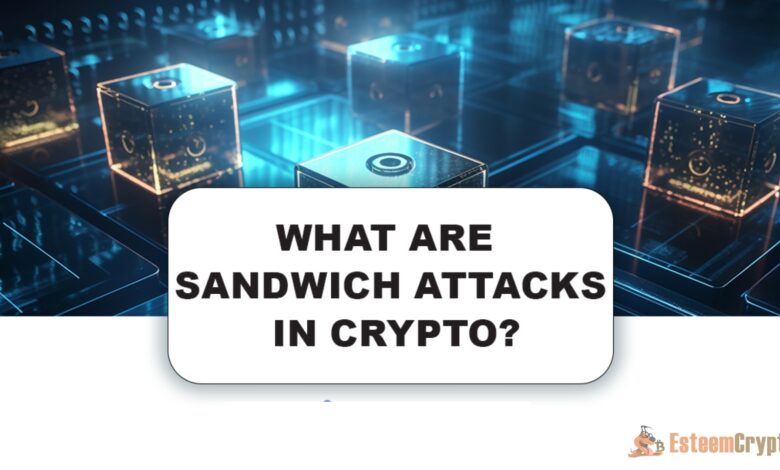Sandwich Attacks in Crypto: How to Prevent them?

Sandwich Attacks in Crypto. A sandwich attack, often called front-running, is a kind of maximal extractable value (MEV) strategy in which the attacker identifies a transaction waiting in the network and purposefully “sandwiches” it by placing orders immediately before and after the intended transaction. While front-running is one of the most well-known types of MEV, there are other types, including back-running and transaction ordering manipulation.
Since transactions on decentralized finance (DeFi) and decentralized exchanges (DEXs) are transparent and appear on the mempool before they are approved, these attacks typically target these systems. Although openness is an essential aspect of blockchain technology, it also inadvertently gives terrible actors the ability to search the chain for any significant pending transactions they might target.
How Do Sandwich Attacks Work?
An attacker uses a bot to front-run transactions (typically larger ones) on a blockchain. This implies that the attacker will use the bot to buy a big buy order right before the victim’s transaction completes, paying a high gas charge to ensure that their transaction completes first. Since the attacker bought the token before the victim, the victim’s price was immediately increased, and the attacker quickly sold the token for a profit from the victim’s transaction. The transaction inflates the attacker’s sell order, which allows the attacker to profit from the manipulated price differential and frequently results in the victim suffering a significant financial loss.
Suppose you’ve been following the cryptocurrency scene for any length of time. In that case, you may be familiar with Jared from Subway.eth, the notorious bot that has only made around $34 million in three months using sandwich attacks. Dune claims that Jared from subway.eth, the top gas user on the Ethereum network, has already spent over $90 million on gas, more than significant cryptocurrency companies like Binance and Crypto.com combined.
It’s crucial to be aware of the several precautions you can take to safeguard your assets because sandwich assaults frequently happen at the expense of your holdings. Additionally, although sandwich attacks are not yet formally prohibited, it is your responsibility to protect your valuables. Let’s now discuss the precautions you can take to shield yourself from sandwich attacks:
Set a Low Slippage
The term “slippage” describes the discrepancy between a transaction’s actual execution and intended prices. This shift results from quickly shifting markets, where an asset’s price can change while you’re trying to execute a trade in a couple of seconds. You are willing to accept the transaction at a price up to 10% higher or lower than the quoted price when you made the deal, for instance, if you set your slippage tolerance to 10%. Otherwise, your order will be cancelled if there has been a 10% or less price fluctuation.
Your transaction can only be completed if the price of your token stays within a specific range if you have selected a low slippage. Your deal will be cancelled and not proceed if an attacker purchases many tokens before you and the token price rises more than your slippage tolerance. Overall, Having a low slippage makes the attack much less advantageous for the attacker because they will be constrained to a much lower profit margin, protecting your tokens if they buy just enough tokens to fall under your slippage range.
The standard 0.5–1% slippage tolerance is usually sufficient for typical price fluctuations. However, it is important to remember that excessively low slippage could lead to an unsuccessful transaction and wasted gas. Your slippage tolerance should be modified considering numerous variables, including particular assets, the token tax, market volatility, etc.
Use Larger Liquidity Pools
You should also attempt to employ larger liquidity pools when conducting a transaction. A liquidity pool is a group of money locked in a smart contract to provide the liquidity required to support transactions on DEXs. Larger liquidity pools tend to be less volatile, which makes the trading environment more stable. They can also reduce price fluctuations resulting from individual transactions.
Therefore, an attacker would need a sizable amount of capital to generate the price variations they profit from in a sandwich assault in a large liquidity pool. Because it would take a lot of money for sandwich attackers to alter the pricing, this can serve as a deterrent.
Pay Higher Gas Fees to Prioritize Transactions
Additionally, traders can consume more gas during transactions, mainly if they conduct larger trades that are more vulnerable to sandwich assaults. Lowering the gas can decrease costs, but slower transactions give the attacker more time to plan and carry out the attack.
The transaction will go more quickly with more gas used, and attackers will need to consume a lot more gas to front-run it. This alone often costs the attackers a lot of money because it requires them to consume very expensive gas, which discourages them from trying to attack the transaction. However, since high gas is frequently costly, consumers should carefully assess their options to protect their investments.
Utilize Telegram Bots
Telegram cryptocurrency bots enable you to swiftly and automatically automate various trades by connecting to your wallet. There are many different types of bots available right now, and while each one has unique capabilities, most of them share similar essential functions such as copy trading, multi-wallet, liquidity, stop loss and take profit orders, anti-rug and honeypot features, and method sniping features. Additionally, some Telegram bots provide features that you can use to protect yourself from sandwich assaults.
Most Telegram bots provide a private transaction feature that lets users conceal the specifics of their trade until it is carried out to sandwich attacks. As previously indicated, a transaction is visible on the mempool before confirmation, and attackers can search the blockchain for pending transactions to target. MEV bots could not examine the transaction details until it was too late for them to front-run the transaction since the transaction data would be hidden under its private function.
Telegram bots with private transaction functionality include Banana Gun Bot, Mizar, and Unibot, to mention a few. Remember that the bots will also access your private keys, which could be dangerous for your security. An exploit on Unibot in October 2023 cost the website $630,000 in revenue. Although Unibot reimbursed consumers impacted by the exploit, this serves as a helpful reminder that although these features are practical, they are not infallible. Users should always take the required safety measures to protect their assets.
Use a Private RPC Network
Apps can access the blockchain network through a remote procedure call (RPC) node. Most traders now use public RPC endpoints that are open to all users. Sandwich attacks arise from the attackers’ ability to scan and inspect the pending transaction on the mempool, as was previously explained. Traders can send their transactions directly to the Ethereum network, hiding their pending transactions behind a private RPC network.
Run Your Node
Running your node is one option for accomplishing this. By setting up your node, you can directly submit and conceal your transactions to thwart assaults. Additionally, you can reduce your reliance on other platforms by having more control over the time and processing of your transactions.
MEVblocker
Another option is to utilize MEV Blocker, an accessible RPC endpoint that guards your trades against MEV. The website claims that the MEV blocker accomplishes this by forwarding the trader’s transaction to a network of searchers who cannot front-run your trades but are searching for back-running chances. Users can add the MEV Blocker to wallets like MetaMask.
Flashbots
Despite their name, Flashbots are not automated systems. A research and development company, Flashbots, is dedicated to studying the MEV market. The organization fights unfair tactics like frontrunning and giving users a fair trading platform. As of right now, the company offers a variety of goods to infrastructure providers, users, validators, and bot operators. Flashbots Protect, Flashbots MEV-Share Node, Flashbots Builders, and other products are currently available from them.
Users of MetaMask wallets can easily incorporate “Flashbots Protect” for Ethereum traders. This function offers additional benefits, such as preventing users’ transactions from reversing and shielding traders from being front-run by MEV bots. By connecting users to a private RPC network, the Flashbots Protect feature enables users to send transactions to miners directly, shielding them from MEV attacks that could occur if they were exposed to the public mempool.
Conclusion
Inadvertently, sandwich attacks take advantage of blockchain technology’s transparency, designed to maintain a level of openness and confidence within the community. InvestBitcoinbitcoin comes with iset of difficulties because it is still less regulated than traditional financial markets. I’m confident that new kinds of assaults will emerge as cryptocurrency develops further. Thereftoer to better protect their investments, traders and investors need to be aware of the possible hazards associated with unethical trading activities.




